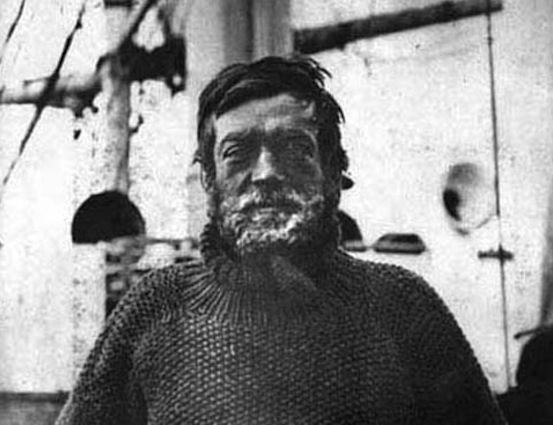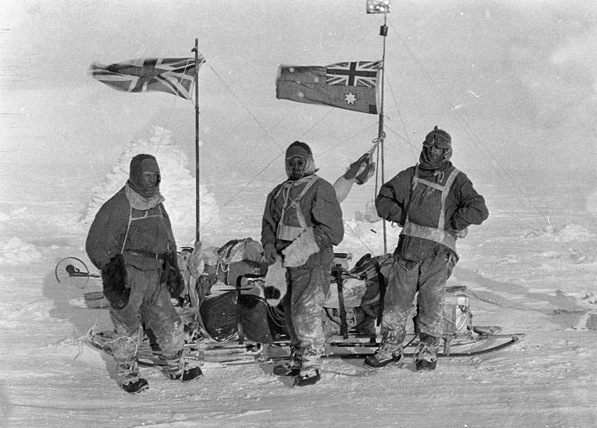
Hoosh
Roast Penguin, Scurvy Day, and
Other Stories of Antarctic Cuisine
Jason C. Anthony
(Nebraska)

Hoosh is essential for any adventures in eating in the Antarctic. If you plan to be going off to Elephant Island or Mount Terror or Butter Point or the Queen Maud Mountains, it would be wise to brush up on preparation of traditional pemmican. Pemmican was devised centuries ago for native Americans hoofing it across the high plains. It's an adroit mix of meat and fat: bison, venison, "cut into thin strips, dried over coals or in the sun, pounded and shredded, then mixed with melted marrow fat and berries as antiscorbutic."Native Americans packed pemmican in bags of uncured bison skin sealed with fat. As bags dried and shrank, the food was as good as vacuum-sealed and could last for years.
Explorers and fur traders bought pemmican in large quantities as a key trade item, right up there with beaver, bear and deer hide. The food-stuff even managed to spout its own fracas (the Pemmican War) in 1816 Manitoba.
Hoosh is packed with facts about the cuisine of the Antarctic. Of all the delicacies there, the one at the top of everyone's Fantastic Food was seal brain. One of the explorer's chefs, Gerald Cutland, devised five recipes for this delicacy, including Seal Brain Omelette, Brain Fritters, and Seal Brains au Gratin. For an omelette, take "two seal brains, chopped up into very small pieces, four penguin eggs, some reconstituted eggs, butter, salt, pepper and mixed herbs."
Cutland might permit seal, but he put his foot down at making Penguin Pot Pie, or at least eating it. "When cooking Penguin, I have an awful feeling inside of me that I am cooking little men who are just a little too curious and stupid."
A penguin even walked into his kitchen one day, and for a moment Cutland thought it was nice of the chap to come to the kettle so fresh, but he didn't have the heart to kill it: "Even though I have cooked many I have always left that job to those who would eat it."
A more typical menu was that enjoyed by the NBSAE expedition (1949 - 1952). "Seal liver and kidneys, breast of penguin with slices of bacon, braised whale steak with onions, whaleburgers, and grilled seal brains. Then there was the feast on local awful offal: heart, tongue, and liver of seal served up with heart, kidneys, liver and testicles of emperor penguin."
These are mostly menus from later explorations. The earlier ones were hardly gourmet journeys in any sense of the word, as the very expeditions themselves may have been nothing but self-promotion for people like Byrd and Scott. Writer Tom Griffiths suggests that "The heroic era of Antarctic exploration was "'heroic' because it was anachronistic before it began, its goal was as abstract as a pole, its central figures were romantic, manly and flawed, its drama was moral (for it mattered not only what was done but how it was done), and its ideal was national honour."
The biggies were Robert F. Scott's Discovery winters (1902 - 1904), Shackleton's South Pole journey, (1908 - 1909), Scott's disastrous Terrra Nova journey (1910 - 1912), Amundsen's successful polar trip (1911 - 1912), Shackleton's Endurance expedition (1914 - 1916), and Richard Byrd's ridiculous (and almost fatal) winter at the Barrier (1928 - 1930). One smaller expedition that Anthony digs up was Jean-Baptiste Charcot's 1903 - 1905 French Antarctic Expedition which "with little drama, settled in for a year to practice excellent science and boldly reveal new land" along the peninsula. The cook was named Rozo. He went about in slippers, baking bread three times a week, and using cormorant and penguin eggs for cakes and custards. No one knew where he came from, where he ultimately went: "another example," says the author, "of how the soul of the kitchen leaves only a faint trace in the mouth of history."
One foodstuff not emphasized was "eating the transport." Once ponies and dogs had outlived their use as pulling power, they became essential sources of protein. Old Dog Tray*** was fried or smoked, even cut up and carried along and eaten raw. En route, the many dogs were culled and killed and fed to the remaining dogs so they could keep on the job. Shackleton opined, "One point which struck us all was how man's attitudes towards food alters as he goes South. At the beginning, a man might have been something of an epicure, but we found that before he got very far even raw horse-meat tasted good." Amundsen put on the dog, too. He recalls the dishes "on which the cutlets were elegantly arranged side by side, with paper frills on the bones, and a neat pile of petit pois in the middle."
There are some fairly disgusting meals here which we need not spend much time on. One that sticks in the mind is Byrd's diet during his self-imposed two year stint at Little America. He never seemed to have mastered the art of melting butter in a frying pan (he cleaned it with a chisel). Lunch was eaten out of a can, dinners he called "a daily fiasco." The author tells us
He ate mostly with his fingers, dining as a solitary man does --- and as Epicurus long ago noted --- like a wolf.
In Alone he claimed to have greeted his rescuers "Hello, fellows. Come on below. I have a bowl of hot soup waiting for you,"
§ § § Hoosh is about food but it is also about transport and logistics: how do you cook atop a mountain in -70° gale-force winds; how much energy should it take to transport so many calories across inhospitable terrain for so many miles so that it doesn't become counterproductive. You don't want to transport food that you will never consume. With these strictures, the law of eating your four-footed companions becomes somewhat more bearable.
Anthony pays due homage to the Primus stove, which contains an early feedback system to where it can melt snow and heat hoosh. Melting snow takes lots of energy, too much. You think you are thirsty so you eat some snow, right? No. It will go to deplete your body's energy; it must be heated elsewhere. Energy, dehydration, caloric intake, scurvy, best foods to take on your next trip to Cape Well Met (citric, oatmeal, fat, pemmican, honey, dried fruit = yes; tinned beef, canned potatoes, Ben & Jerry's = no). A few recipes are included in the Appendix, including this for Sautéd Penguin:
Penguin breasts
1 cup dried onion
1 tin tomatoes
1 tin tomato soup
4 ounces butter
Mixed herbs
Salt and pepper to taste
Cut the penguin breasts into small pieces and fry in the butter until brown then add the onion. Drain the tomatoes and mash half the tin into a purée, then stir into the meat and onion mixture. Add salt and pepper and some mixed herbs and the tomato soup. Simmer until the meat is tender and the sauce has been thickened.§ § § This is fine adventure. The pretense is that it is the South Pole Lifestyle cookbook but it is really an excellent summary of a time when to prove your manhood all you had to do was raise a million dollars and spend a year freezing your ass off in the most ghastly place on earth while starving.
We have previously posted a couple of on-line reviews and readings about roaming Antarctic Hot Spots. Most highly recommended is a review of The Worst Journey in the World by Apsley Cherry-Garrard, with a sublime (and scary) reading from that book. And, although it is full of lies and general hooliganism, Byrd's Alone is worth it for the simple but poetic rendering of how to kill yourself in a romantic way.
--- L. W. Milam *** The morn of life is past,
*** The morn of life is past,
And evening comes at last;
It brings me a dream of a once happy day,
Of merry forms I've seen
Upon the village green,
Sporting with my old dog Tray.
Chorus: Old dog Tray's ever faithful,
Grief cannot drive him away,
He's gentle, he is kind;
I'll never, never find
A better friend than old dog Tray.--- Old Traditional Dog-Love Song